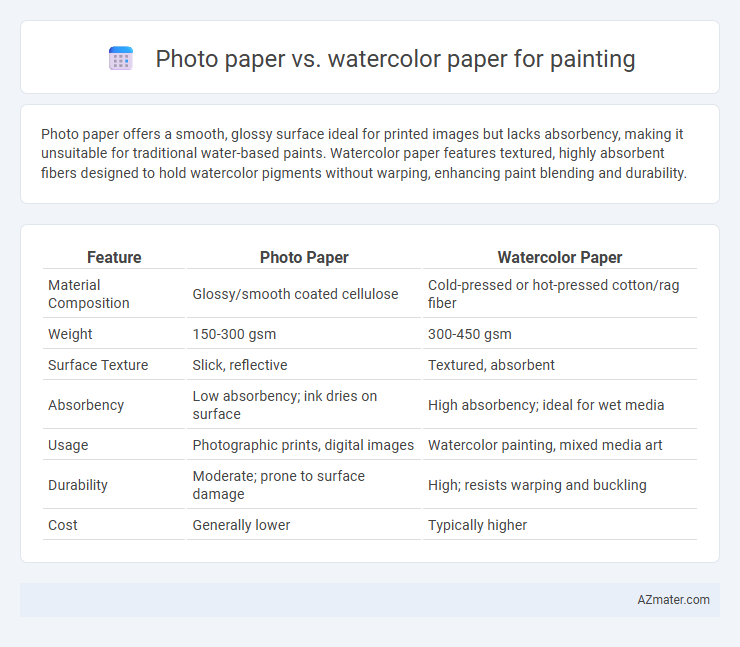Photo paper offers a smooth, glossy surface ideal for printed images but lacks absorbency, making it unsuitable for traditional water-based paints. Watercolor paper features textured, highly absorbent fibers designed to hold watercolor pigments without warping, enhancing paint blending and durability.
Table of Comparison
| Feature | Photo Paper | Watercolor Paper |
|---|---|---|
| Material Composition | Glossy/smooth coated cellulose | Cold-pressed or hot-pressed cotton/rag fiber |
| Weight | 150-300 gsm | 300-450 gsm |
| Surface Texture | Slick, reflective | Textured, absorbent |
| Absorbency | Low absorbency; ink dries on surface | High absorbency; ideal for wet media |
| Usage | Photographic prints, digital images | Watercolor painting, mixed media art |
| Durability | Moderate; prone to surface damage | High; resists warping and buckling |
| Cost | Generally lower | Typically higher |
Introduction: Photo Paper vs Watercolor Paper
Photo paper and watercolor paper serve distinct purposes in the art world, with photo paper designed primarily for high-resolution photographic prints, offering a smooth, glossy, or matte finish that enhances image clarity and color vibrancy. Watercolor paper, made from cotton or cellulose fibers, provides a textured and absorbent surface ideal for water-based media, allowing pigments to blend and spread naturally without warping. Selecting the appropriate paper depends on the desired medium and effect, as photo paper excels in sharp detail reproduction while watercolor paper accommodates fluid brushwork and color layering.
Key Material Differences
Photo paper is typically coated with a smooth, glossy or matte surface designed to hold ink from printers, making it less absorbent and prone to quick drying, while watercolor paper is made from cotton or cellulose fibers with a textured, absorbent surface ideal for holding water and pigment. Watercolor paper's thickness and durability prevent warping and allow for layering of washes, whereas photo paper's thin, non-porous nature limits its use to detailed, ink-based images. The fiber content and surface treatment are critical; watercolor paper's archival quality supports longevity in paintings, while photo paper is optimized for photographic clarity but not for traditional painting techniques.
Surface Texture Comparison
Photo paper features a smooth and glossy surface ideal for sharp, vibrant image reproduction, while watercolor paper offers a textured, absorbent surface designed to hold pigments and water effectively. The toothy texture of watercolor paper enhances paint adhesion and creates varied effects, whereas photo paper's slick finish limits paint absorption and texture variation. Choosing between the two depends on the desired artistic outcome, with watercolor paper favored for traditional painting techniques and photo paper suited for precise photographic prints.
Absorption and Paint Handling
Watercolor paper offers superior absorption due to its textured, fibrous surface, allowing it to hold watercolor pigments effectively without warping, ideal for fluid paint handling and color blending. Photo paper, coated and smooth, lacks adequate absorbency, causing water-based paints to pool or run, limiting control over paint application and detail work. For techniques requiring precise control and layering, watercolor paper's absorption properties enhance paint adherence and durability compared to glossy photo paper.
Durability and Longevity
Watercolor paper, typically made from 100% cotton, offers superior durability and longevity compared to photo paper due to its thick, textured surface designed to absorb water and pigments without warping or deteriorating. Photo paper, often coated with a glossy or matte finish, is vulnerable to fading, cracking, and damage from moisture over time, making it less suitable for long-term artwork preservation. Artists seeking archival quality and lasting vibrancy commonly prefer high-grade watercolor paper for painting projects demanding durability.
Color Vibrancy and Finish
Photo paper enhances color vibrancy with its glossy or satin finish, producing sharp, vivid images ideal for detailed artwork and photography prints. Watercolor paper offers a textured, matte surface that absorbs paint, creating softer tones and a natural finish suitable for traditional watercolor techniques. Choosing between photo paper and watercolor paper depends on the desired finish and color intensity, with photo paper delivering brighter visuals and watercolor paper providing subtle, blend-rich effects.
Best Uses for Each Paper Type
Photo paper excels in producing sharp, vibrant prints with high color accuracy, making it ideal for detailed photographic reproductions and digital artwork. Watercolor paper features a textured surface and superior absorbency, perfect for handling water-based paints like watercolor, gouache, and acrylics, allowing for smooth blending and minimal warping. Artists select photo paper for crisp, glossy finishes and watercolor paper for traditional painting techniques requiring durability and texture.
Cost and Accessibility
Photo paper generally costs less and is more widely available in standard retail stores, making it an affordable option for beginners and casual artists. Watercolor paper, often pricier due to its specialized texture and weight, is primarily found in art supply shops and offers superior durability and paint absorption. Accessibility to watercolor paper may be limited in some areas, while photo paper's convenience and cost-efficiency appeal to budget-conscious painters.
Artist Testimonials and Experiences
Artists consistently highlight that watercolor paper offers superior texture and absorbency, essential for layering washes and achieving vibrant color depth. Photo paper, while smooth and ideal for photo printing, often receives criticism from painters for its lack of durability and poor pigment retention. Many painters recommend watercolor paper for its archival quality and ability to handle various wet media without warping, as reflected in numerous artist testimonials.
Conclusion: Choosing the Right Paper for Your Painting
Choosing the right paper for your painting depends on the medium and desired texture; photo paper offers a smooth, glossy surface ideal for digital prints and photographic art, while watercolor paper provides a textured, absorbent surface that enhances the vibrancy and blending of water-based paints. Artists working with traditional watercolor, gouache, or mixed media benefit from the durability and archival quality of cold-pressed or hot-pressed watercolor paper. For inkjet prints or detailed photo reproductions, high-quality photo paper delivers sharp, vibrant images with a professional finish.

Infographic: Photo paper vs Watercolor paper for Painting
 azmater.com
azmater.com